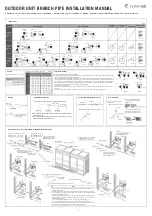
IM-DHMSHA-02 Specifications subject to change without notice.
13
FINAL TUBING CHECK
IMPORTANT:
Ensure the certain factory tubing on the indoor unit
has not shifted during shipment. Ensure the tubes are not rubbing
against each other or any sheet metal. Pay close attention to feeder
tubes and ensure the wire ties on the feeder tubes are secure and tight.
DRAIN CONNECTIONS
Connect the drain line. The drain line must not have a trap anywhere
in its length, must pitch downwards, and must be insulated up to the
outside wall (see Fig. 20). By default, the drain hose is attached to the
left-hand side of unit (when facing the back of the unit). However, it
can also be attached to the right-hand side.
a. To ensure proper drainage, attach the drain hose on the
same side that your refrigerant piping exits the unit.
b. Attach a drain hose extension (purchased separately) to the
end of the drain hose.
c. Wrap the connection point firmly with Teflon tape to
ensure a good seal and to prevent leaks.
d. For the portion of the drain hose that remains indoors, wrap
it with foam pipe insulation to prevent condensation.
e. Remove the air filter and pour a small amount of water into
the drain pan to ensure that water flows from the unit
smoothly.
Plug the Unused Drain Hole
To prevent unwanted leaks, plug the unused drain hole with the rubber
plug provided.
Fig. 20 — Proper Drain Hose Installation
NOTE: For proper orientation of the refrigerant piping,
electrical cable and drain lines, refer to Fig. 21.
Fig. 21 — Bundle drain hose, refrigerant pipes, and
signal cable
NOTE: The factory insulation provided with the product is
sufficient, therefore adding additional insulation to
the refrigerant pipes is NOT recommended.
Additional insulation may keep the product from
attaching flush to the wall.
NOTE: For applications where gravity cannot be used for
drainage, a condensate pump accessory is
available. Consult the condensate pump
Installation Instructions for more information.
WIRELESS REMOTE CONTROL
INSTALLATION
Mounting Bracket (if installed on the wall)
1. Use the two screws supplied with the wireless remote control to
attach the mounting bracket to the wall in a location selected by the
customer and within operating range.
2. Install the batteries in the remote control.
3. Place the remote control into the remote control mounting bracket.
NOTE: For remote control operation, refer to the unit
Owner’s Manual.
WIRED REMOTE CONTROL
INSTALLATION
To connect the wired remote controller KSACN0101AAA (Timer
Function) to the indoor units, connect to the 4-pin connector located
on the display board.
To connect the wired remote controller KSACN0401AAA (7 Day
Programmable) to the indoor units:
1. Replace the display board with the shipped with the kit.
2. Install the adapter board (shipped with the kit).
3. Connect the adapter board to the new display board. Follow the
instructions on the wired controller KSACN0401AAA installation
instructions manual for more details.
4. Connect the female molex plug on the adapter board to the male
molex plug from the extension cable shipped with the kit.
5. Connect the extension cable to the wired controller
For setup instructions, refer to the controller installation manual.
START-UP
Test Operation
Perform a test operation after completing a gas leak and electrical
safety check (see Fig. 22).
Fig. 22 — Test Operation
1. Push
ON/OFF
on the remote control to begin testing.
NOTE: A protection feature prevents the air conditioner
from activating for approximately 3 to 4 minutes.
2. Push
MODE
, select
COOLING
,
HEATING
,
FAN
mode to check
that all functions work correctly.
3. To run the test using the
MANUAL
button on the indoor unit:
a. Open the front panel of the indoor unit;
b. Push
MANUAL
once to energize the unit. The set
conditions for manual operation are as follows:
•Preset set point: 76
F (24
C)
•Fan speed:
AUTO
•Discharge air direction: Pre-set position based on operation
in the
COOL
or
HEAT
mode.
4. Be sure to set the
MANUAL
button to
OFF
(by pushing it twice
again) after completing the test operation.
r
e
t
a
w
o
t
n
i
d
n
e
n
i
a
r
d
t
u
p
t
o
n
o
D
r
e
p
o
r
P
Do not form a rise
Indoor Unit
Space behind unit
Refrigerant piping
Drain hose
Signal wire
Insulation tape
Manual control
button
AUTO/COOL
































